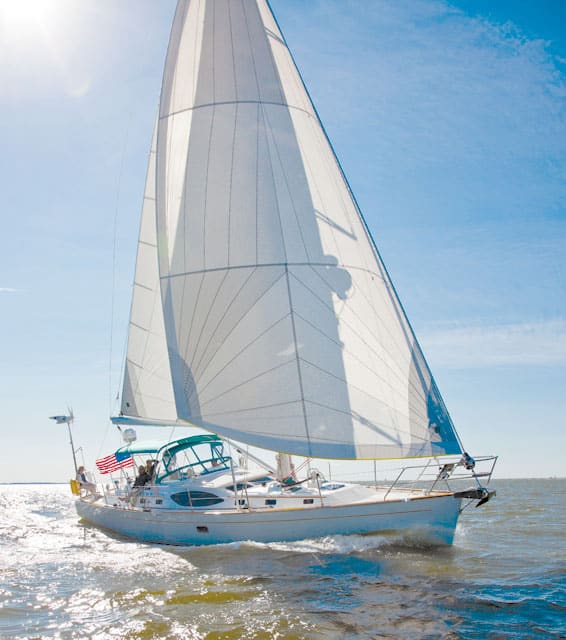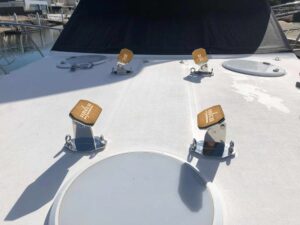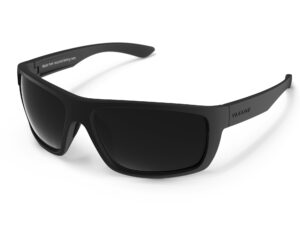
General Overview
The Valiant 40 and Passport 545 are separated by almost 30 years of design evolution, yet their needs and goals in circumnavigation remain similar and constant for both: Value, durability, safety, and flexibility of sailing range during the wide range of conditions they will see during their voyages. Both boats are ‘cutter’ rigged but it is here that the 30 years of evolution really shows differences.
Though the differences between the two are striking, the compelling reasons that cutter rigs are preferred by world cruisers are twofold:
- reduction of overall sail sizes for ease of handling and
- flexibility of sail choices and reefing options.
Both of these points make sailing easier and safer.
Differences
The Valiant 40 is what most would call a traditional cutter; fit with a Yankee (high clewed furling foresail with small overlap) and an inner staysail that is small and robust for design to fly under the Yankee in most conditions and excelling as a heavy air / storm sail. The staysail might be attached with hanks on the inner forestay or on a furler so we will need to look at this. The mainsail is also ‘traditional’ in that that it was originally designed with conservative roach and short leech battens. The reefing system is traditional jiffy reefing with the clew reef lines led aft, but may have been updated to incorporate the luff reefs leading aft as well, but either way it is a very functional system. The mast will be without a contemporary track system and may or may not have auxiliary track for a storm trysail.
The Passport on the other hand illustrates contemporary design concepts and engineering. The ‘cutter’ part of the sail plan consists of a full size furling jib that is non-overlapping for ease of use and is used as the primary upwind sail in most conditions and a large overlapping Furling ‘reacher’ or ‘screacher’ that can be used as the light air upwind genoa and an across the board reaching/downwind sail.
The mainsail is an in-mast (Selden) furling mainsail, which gives the owners ease of use and an unlimited reefing capability. It is a testament to these systems and their improved engineering over the years that we now take it for granted that they will work reliably for something as trying as a circumnavigation.
Design Approach
Our work with the Valiant owners will be more comprehensive in the sense that we will review and most likely recommend some rigging upgrades that will enhance safety, sail longevity and ease of use for the owners. We would suggest upgrading the track system to an aftermarket track and slide system. The range for these is great in cost, so our recommendations for a specific track system would be based on their budget. A track system allows the mainsail to go up and down easily which helps when reefing and stowing the sail and also allows us to comfortably fit 2 or more full battens to the mainsail that will add sail control when handling the sail and improve the longevity of the sail by reducing or tempering the tendency for the leech to ‘flog’ during hoisting, dowsing and normal use. We would also discuss the pro/cons of converting the staysail to furling if the budget allows for it. In addition, we will want to add a storm trysail track if the boat is not currently equipped with one.
The Passport owners benefit from having a newer boat that is rigged in a more contemporary fashion…so really we just need to discuss options for sails and additional sails for offshore work.
Any time we discuss sails for world cruising we always make sure that we include our Tradewinds Specifications in the mix. This is a group of finishing techniques that we developed for the rugged Hawaiian Charter fleets, where wind, use and loads are extreme. We transferred this to our offshore sails as an option and do some serious finishing enhancements such as extra point loading reinforcements, double edge tapes, extra heavy thread throughout, all designed to further the life of the sails and reduce mid-cruise maintenance. This is almost mandatory for our world cruising clients.
Sails
A must for all world cruisers is space onboard and the need for room below can’t be understated, for this reason we always look to build and provide the fewest number of sails that have the widest possible range of use. So given both boats are cutters, we are already well on the way to keeping the inventory in a minimalist/maximum mode. The few auxiliary sails we will recommend to both clients is a downwind sail (nylon) and the required storm trysail and storm jib (if needed). Both will need storm trysails. The Passport Selden mast comes built with a slot on the section for this need and the Valiant will need track for this sail if it isn’t so equipped.
You might ask, why a trysail? It is important to remember that the storm trysail is a purpose built sail that is designed for tough conditions when you might have to heave to…say in 55knots or more or when the sea state and/or condition of the crew require setting the boat for a more restful motion. By letting this small rugged sail do this work, the primary mainsails are stowed or furled and out of harm’s way and you will know that they will be ready to go once the weather clears. In the case of the Valiant main, we would recommend two deep reefs AND the trysail combination instead of 3 reefs…for this reason alone. The trysail can be fitted to the mast tracks with sheets and downhaul line already fixed to the sail, stowed in the bag and lashed to the base of the mast. In this fashion, it’s ready to go and not stowed down below.
The other storm sail required is the storm jib. The options are a bit more fluid here. The Valiant could easily be set up with a heavily built staysail with bronze hanks and a reef which then could be used as a storm jib or conversely, if the staysail is furling, we can build it extra rugged and it can be reefed to storm jib size.
The Passport is trickier; as the large furling and self-tacking jib will be difficult to make heavy enough and not alter its all-around performance and importantly, with the athwartship track, it will be difficult to have it sheet correctly when furled to a storm jib size. In this case we would look to alternative storm jib options such as the ATN ‘Gale’ sail or our own ‘Tempest’ storm jib. Both system work in concert with the furled headsail, allowing the user to hoist a somewhat independent storm jib without having to take the furled genoa down.
The last auxiliary sail on the list would be a cruising asymmetric spinnaker. Most are familiar with these now and how they are flown and used. Sailing lower angles in the trades and in light air sailing in general they can’t be beat for boat speed improvement. Design evolution over the years has led us to a sail that can be effective at wind angles of 50-170 degrees and even sail at 180 when wing and wing. Sailing angles for the asymmetric dictated by wind strength… in other words sailing at 55 degrees in 6 knots of breeze is impossible but not in 12 knots of breeze and conversely you won’t sail low angles in light air.
In recent years there have been developments with furling systems of various types. (top down, auxiliary line, and inline systems) After significant use and testing of the different types, we would still recommend the now traditional ‘dousing sock’ approach to asymmetric sail handling. For offshore work most will find the sock less cumbersome, lighter and they take up less space. The handling of both the sock and furling systems are similar in terms of setting up and taking down, they differ in the actual ‘dousing’ technique, one furling and one being ‘doused’ by the sock. The furling system actually requires more physical effort than socks which come down will relative ease when the spinnaker is collapsed. The furling systems require much more physical effort to spin either the sail/torque rope combination or the external top down torque rope systems.
Regardless of system, the sails are a must and if there is a word of caution to be mentioned I always remind sailors how big and powerful these sails are and as such the following three rules should be followed:
- Know if the wind is building. Take down early and go to your conventional sails to be safe
- Always have 3 or more wraps of the spinnaker sheet on the winch. These sails can exert tremendous forces on the sheets should the sail collapse and fill as happens during a gybe. Keep your fingers!
- In passagemaking do not be tempted to fly the spinnakers at night unless you have a full crew and are very aware of the weather. Bad things happen at night and they are difficult to deal with in the dark, making it unsafe for all.
Fabric
Our general cloth recommendations for world cruisers are still woven polyester sailcloth as this material represents great value, durability and longevity. We have woven polyester sails on world cruisers go in excess of 80,000 nautical miles in the southern ocean which is no small feat.
Woven goods come in different styles and there are not ‘bad’ fabrics and ‘good’ fabrics, rather there are correct fabrics for specific applications and some not so right for a given job. A good example of this would be the Challenge Sailcloth 8.03 low aspect / high modulus fabrics versus their 8.3 high aspect / high modulus fabric. The 8.03 will make great cruising sails in part because of the balanced nature of low aspect fabrics which get a lot of bias (off threadline) stability from the mechanics of the weave (and not relying on resins as much) and because the yarn types in both directions are of similar size, they present a balanced rate of U.V. degradation. While the 8.03 may have a bit more stretch over time, they will last for years and years in the harsh U.V. conditions they will be exposed to. The 8.3 on the other hand is a very unbalanced product, with yarn sizes in a 3.3:1 ratio. The larger yarns are in the fill direction (along the leech of the mainsail for example) which makes for great strength and stretch resistance, but the warp yarns, which encapsulate the fill yarns, are 3 times as small…and these yarns see the brunt of U.V. and chafe. The result is a great fabric for a high aspect club racer, but not really a good fabric at all for a world cruiser. This knowledge of fabric construction, finishing and use, will be outlined and understood by a good sailmaker. They will work to direct customers to the right fabric…not just for budget, but for the practical long term interest of the sailors.
But this isn’t to say that there aren’t plenty of other great fabrics and build techniques that can be applied to all of these sails. However the price differential of higher end fabrics and composites (sometimes 4 times the cost) can make a sailors budget explode. We would approach this on a case by case basis as clearly there are owners who have higher aspirations and bigger budgets and are willing to make the investment in some of the higher end constructions.
Upgrade woven fabrics such as HydraNet, Warp-Drive (for example) and composite sails all offer the sailmaker the opportunity to better engineer sails and reduce the weight somewhat as well. Sails made with these fabrics/constructions also tend to hold their original ‘design’ shape longer than woven polyester, and in the case of HydraNet or Warp drive they will last just as long as traditional woven fabric. Composites generally do not have as long a ‘physical’ life as the woven goods. It is important to remember the performance value of shape retention and weight aloft that the higher end fabrics and constructions will provide, but keep this in mind; these boats are heavy displacement monohulls, sailmakers are not magically going to coax more top speed out of these hulls…we may improve the performance (the need to reef will be further up the wind range or getting up to hull speed sooner in light air as examples) but once you’ve reached a balance between hull speed and wind velocity, your speed is your speed. The other critical component to consider is that some 70% of cruising and maybe more in the case of these two owners sailing the trades, will be off-the-wind. Boat speed and performance differences off the wind really minimize as you sail lower. The boats will easily reach hull speed when reaching and sail materials and sail cuts have less importance than the sheer size of the sails you put up. (That’s why we have spinnakers!)
Mainsails
Here the boats are most different and approaches quite different. The Passport mainsail construction and size are defined by the mechanical system of the furler. The only new contemporary option for furling mainsails is to increase the area by giving the mainsail a bit of positive roach that is supported by vertical battens. Although these systems have now been around for many years and proven to be relatively hassle free, we would recommend staying away from any battens for a world cruiser… as the potential for increased maintenance (chafe on batten pockets) from going in and out of the mast as well as the off chance that there is a furling mishap or override the addition of battens to this sail make will make it more difficult to clean up.
The one really big benefit of furling mains is that you have an infinite reefing system…so your ability to balance the helm through sail size can be adjusted for wind, sea, boat weight, comfort. With conventional jiffy reefing you have 1,2 or 3 reefs and the area reduction is fixed.
Fabric choices would include: Challenge 10.11WarpDrive polyester, HydraNet 433 poly/dyneema or the Contender 10.6 Fibercon Hybrid poly/dyneema for radially constructed sails and the Challenge High Mass weave for the cross-cut application.
The Valiant mainsail is restricted by rig size…and we generally do not recommend pushing the roach past the backstay to save the chafe and hassle of clearing the leech in light air. Maximize the area based on the rig and move on.
But given the age of the boat we can still make some really solid improvements…the most important will be going to an aftermarket track system and fitting the new main (regardless of material choice) with full battens. We love full battens in cruising applications…they stabilize the sail which makes it easier to handle whenever it’s going up or down and the damping effect of the battens extends the life of the material significantly. They are a low cost investment in making sure the sail has a long life.
Fabric choices would include: Challenge 8.11WarpDrive or HydraNet 343/ Contender 8.65 Fibercon hybrid for radially constructed sails and the Challenge 9.88 High Mass weave for the cross-cut application.
Headsails
The Passport primary furling jib size is restricted by the self-tacking/athwartship track system, whereas the reacher we have more latitude in size and design. The Reacher should be fairly high clewed (think boom height) and could be as large as a 150%. The higher clew will reduce the need to play with the genoa cars when conditions or angles change as they are more forgiving in this way. It also gives you good visibility under the sail when you are charging around the seas.
Materials for this sail can be lighter and I would prefer to see a radial cut as loads change and move around quite a bit as this sail will see many different angles and wind strengths.
In this format, we would offer a mid-weight radial Dacron like the Challenge 6.51 Radial Weave and as an upgrade fabric the Challenge 6.11 Warp-Drive. I don’t see any benefit to going to a high end construction or fabric in this instance. As a light air upwind sail and reaching sail the loads don’t warrant the need for expensive yarn types. Both sails would be fit with Acrylic U.V. or maybe Weathermax as a lighter but stronger alternative to the heavier acyrlics.
I would stay away from light weight U.V. coated Dacron cover materials as they won’t have the lifespan required for this type of sailing.
The Valiant headsails have a bit more flexibility. As I mentioned, if we continue to use brass hanks on the staysail, we could build a ready bag for it to stow in on the deck when not in use and fit the sail with a reef that would allow the owners to use it as a storm jib. And if the staysail is on a furler, we would bump the construction details up a bit, to ensure it can be used as storm jib as well.
We generally make staysails of this type the same weight as mainsails…as they have to perform in the upper wind conditions as do the mains. In cross-cut woven goods we would look at the Challenge 9.88 or the Contender 9.4 as very good balanced materials with good U.V. properties. In a radial configuration; the Hydranet 343 or 8.11 WarpDrive would be good choices.
The yankee will remain a high clewed sail with an overlap of 95-110% only. It will be built ruggedly as well, as typically a boat with this configuration will use a small Yankee up into the 20 knot range of wind before partially reefing or going to the staysail. Therefore, fabric choices would be heavier than you might expect.
Cross-cut fabrics would be the 8.5oz range and again, balanced construction is key here. With radial cuts you could step down to the HydraNet 303, the Challenge 7.11 WarpDrive or the Contender 7.65 Fibercon Hybrid.
U.V. materials would be as with the Passport…emphasis on durability and less on weight savings.
Auxiliary Sails
Spinnaker: The choice here as I mentioned is an asymmetric. This sail for both boats will be built in 1.5oz nylon as it has much better tear resistance, U.V. life and strength than .75oz. nylon. The heavier weight of the .15 is not a liability because when these sails are used, the apparent wind is always built up in order to get the boat moving…so they are always ‘pressed’ and the weight of the fabric is not an issue in its ability to fly. Construction details for offshore work should include ‘felled’ seams with no raw edges and plenty of reinforcement and the cross-seams, staggered radial patches. A good construction upgrade is to go to ‘soft’ clew corner, eliminating the large stainless ring. Less metal flying around in space is always a good thing when sailing.
Storm sails
The Passport as mentioned will need to rely on an aftermarket sail to fit around the furled headsail. The Valiant can go with a purpose built storm jib that hangs on to the inner forestay or use the staysail as a storm jib.
Both will require storm trysails as mentioned.
Having outlined their use a bit already, I’ll just comment on construction and size.
The areas of storm sails are normally governed by the ORC formula for maximum storm sail area. In practical experience we find that this area is too big and generally recommend the storm sails to be 20-25% smaller than this.
Storm sail construction is NOT a place to go cheap. Build it right; build it in the right material with the right hardware. If you are hunkered down below riding out a full gale or more and 25’ seas, you do not want to worry about the integrity of your storm sails. You’re going to keep your eye on the radar and go topsides to check chafing gear on sheets, but you needn’t worry that the sails are not up to the task.
This means large seams and stitching, it means big patches and extra reinforcement at all point loading spots. It means large foot and leech-lines that can be tied to stainless eyelets and not cleated to plastic cleats.
And we always make them in heavy duty rugged woven polyester with the one option of using distress orange color which improves the visibility of a vessel using them in cresting/foaming seas. In these conditions, a white sail coming up out of trough is hard to see when the wave tops are white and spraying. Having the storms sails in orange really can help others see you.
Storm jibs should always be flown on a tack pennant as it will help with proper sheeting but importantly get the sail up out of the way of the green water that is sure to roll across the deck from time to time.
Storm trysails should have two sheets permanently attached to the clew and designed to go to the spinnaker blocks. The clew position is then triangulated between the two sheets. They also must have a downhaul line so that you can float the sail up and down on the trysail track effectively adjusting your lead position in this manner. All of this should be tested, pre-set and marked, so deploying it requires little thought and can be done quickly!








